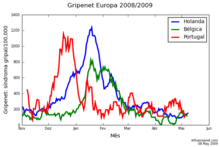Influenzanet
Influenzanet is a syndromic surveillance system that monitors the activity of influenza-like illness (ILI) with the help of volunteers via the Internet. This innovative surveillance system is based on the voluntary online participation of the population who, on a weekly basis, respond to an internet questionnaire about flu symptoms.
During the winter 2003/2004 season, the Netherlands and Belgium launched the first Influenzanet - De Grote Griepmeting [1]- which attracted over 30,000 participants in the first year.[2] The Dutch Great Influenza Survey has been carried out yearly since then. It was implemented in Portugal for the 2005/2006 season;[3] this was followed by the Italians with Influweb in 2008,[4] and then by the French version called GrippeNet in 2012.[5]
With the threat of a new pandemic influenza, three other countries joined this project in 2009, with the implementation of Gripenet Brazile,[6] in Brasil; Reporta in Mexico;[7] and the Flusurvey in the United Kingdom.[8] In Australia, a comparable project called Flutracking started in 2006 with 400 "Flutrackers" completing a 10 - 15 second online survey about flu-like symptoms each week has over 8,000 weekly participants in 2010.[9]
How it works

Any resident of the participating countries can register by completing an online application form containing various medical, geographic, and behavioural questions. Every week during the flu season, participants are asked to select from a list of symptoms the ones they have experienced since their previous visit to the website. Participation is stimulated by email newsletters, online educational materials, competitions and presentations, and other educational activities.
A case of ILI is defined based on a set of reported symptoms: acute onset of fever of >=38 °C, plus muscle pain, plus one of the following: cough, sore throat, and/or chest pain. The daily incidence of ILI is determined by the number of participants with an onset.
The results of the influenzanet closely matches the official EISS data.[10]
References
- ↑ "De Grote GriepMeting" (in Dutch). Degrotegriepmeting.nl. Retrieved 2013-07-01.
- ↑ Marquet, RL; Bartelds AI; van Noort S; Koppeschaar C; Paget J; Schellevis FG; van der Zee J (1 July 2006). "Internet-based monitoring of influenza-like illness (ILI) in the general population of the Netherlands during the 2003–2004 influenza season". BMC Public Health. 6: 242. doi:10.1186/1471-2458-6-242. PMC 1609118
 . PMID 17018161.
. PMID 17018161. - 1 2 "Gripenet" (in Portuguese). Gripenet.pt. Retrieved 2013-07-01.
- ↑ "Influweb" (in Italian). Influweb.it. Retrieved 2013-07-01.
- ↑ "Accueil" (in French). grippenet.fr. Retrieved 2013-07-01.
- ↑ http://www.gripenet.com.br Archived May 15, 2009, at the Wayback Machine.
- ↑ "REPORTA: Sistema Ciudadano de Monitoreo de Enfermedades Respiratorias" (in Spanish). Reporta.c3.org.mx. Retrieved 2013-07-01.
- ↑ "fLU sURVEY". Flusurvey. Retrieved 2013-07-01.
- ↑ "FluTracking". Flutracking.net. Retrieved 2013-07-01.
- ↑ van Noort, S; Muehlen M; Rebelo de Andrade H; Koppeschaar C; Lima Lourenço JM; Gomes MGM (1 July 2007). "Gripenet: an internet-based system to monitor influenza-like illness uniformly across Europe". Eurosurveillance. 12 (7).